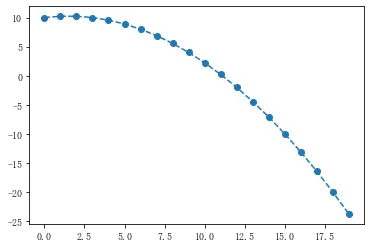缺失值和异常值处理
分类:
IT文章
•
2022-05-20 22:52:43
一、缺失值
1.空值判断
isnull()空值为True,非空值为False
notnull() 空值为False,非空值为True
s = pd.Series([1,2,'3',np.nan,'hello',np.nan])
df = pd.DataFrame({'a':[1,2,np.nan,'3'],'b':[2,np.nan,'3','hello']})
print(s.isnull())
print(s[s.isnull() == False]) #求s中的非空值,或者直接s[s.notnull()]
print(df.notnull())
print(df[df['b'].notnull()]) #求s中的非空值,或者df[df.isnull() == False]
![]()
0 False
1 False
2 False
3 True
4 False
5 True
dtype: bool
0 1
1 2
2 3
4 hello
dtype: object
a b
0 True True
1 True False
2 False True
3 True True
a b
0 1 2
2 NaN 3
3 3 hello
结果
2.空值删除
dropna()删除所有出现空值的行,即任何一个字段出现空值该行都会被删除。
dropna()默认返回删除空值后的数据且不修改原数据,加参数inplace=True直接修改原数据
s = pd.Series([1,2,'3',np.nan,'hello',np.nan])
df = pd.DataFrame({'a':[1,2,np.nan,'3'],'b':[2,np.nan,'3','hello']})
print(s.dropna())
df.dropna(inplace = True)
print(df)
![]()
0 1
1 2
2 3
4 hello
dtype: object
a b
0 1 2
3 3 hello
结果
3.空值填充
fillna(value=None, method=None, axis=None, inplace=False, limit=None, downcast=None)
value 指定value填充空值,默认为None
method 填充方法,backfill/bfill使用后面的值填充,pad/ffill使用前面的值填充,默认为None
inplace 默认为False不修改原数据
limit 如果有多个空值,最多修改多少个
s = pd.Series([1,2,'3',np.nan,'hello',np.nan])
df = pd.DataFrame({'a':[1,2,np.nan,'3'],'b':[2,np.nan,'3','hello']})
print(s.fillna(0))
print(s.fillna(0,limit = 1))
print(df.fillna(method = 'bfill'))
![]()
0 1
1 2
2 3
3 0
4 hello
5 0
dtype: object
0 1
1 2
2 3
3 0
4 hello
5 NaN
dtype: object
a b
0 1 2
1 2 3
2 3 3
3 3 hello
In [41]:
结果
4.空值替换
replace(to_replace=None, value=None, inplace=False, limit=None, regex=False, method='pad')
to_replace 被替换值
value 替换值
method 如果不指定value,使用method指定的方法进行替换,pad/ffill使用前面的值替换,backfill/bfill使用后面的值替换
limit 如果被替换的值有多个,最多替换多少个
s = pd.Series([1,2,'3',np.nan,'hello',np.nan])
print(s.replace(np.nan,method = 'bfill'))
![]()
0 1
1 2
2 3
3 hello
4 hello
5 NaN
dtype: object
结果
5.缺失值处理方法
①直接删除空值(根据实际意义,如果缺失值占比<2%且不好填充,可考虑直接删除)
②使用均值/中位数/众数填充
③使用前值/后值填充
④插值,拉格朗日插值法
from scipy.interpolate import lagrange
x = [3,6,9]
y = [10,8,4]
print(lagrange(x,y),type(lagrange(x,y)))
print(lagrange(x,y)(15))
df = pd.DataFrame({'x':np.arange(20)})
df['y'] = lagrange(x,y)(df['x'])
plt.plot(df['x'],df['y'],linestyle='--',marker = 'o')
# -0.1111 x^2 + 0.3333 x + 10 <class 'numpy.poly1d'>
# -10.000000000000004

s = pd.Series(np.random.rand(100)*100)
s[3,6,33,56,45,66,67,80,90] = np.nan
print('数据个数为%d'%len(s))
s_na = s[s.isnull()]
print('缺失值个数为%d'%len(s_na))
print('缺失值占比%.2f%%'%(100*len(s_na)/len(s)))
s_handle = s.fillna(s.median())
fig,axes = plt.subplots(1,4,figsize = (20,4))
s.plot.box(ax = axes[0],title = '数据分布')
s.plot(kind = 'kde',linestyle = '--',ax = axes[1],title = '折线图(默认删除缺失值)')
s_handle.plot(kind = 'kde',linestyle = '--',ax = axes[2],title = '折线图(中位数填充缺失值)')
def f(data,n,k = 5):
y = data[list(range(n-k,n+1+k))]
y = y[y.notnull()]
return lagrange(y.index,list(y))(n)
for i in range(len(s)):
if s.isnull()[i]:
s[i] = f(s,i)
print(i,f(s,i))
二、异常值
异常值是指样本中的个别值明显偏离其余的样本值,异常值也称离群点,异常值的分析也称为离群点的分析。
1.异常值鉴定
①3α原则
对于服从正态分布的样本数据,通常认为 |样本值-均值| >3倍标准差的样本值为异常值。在实际工作中可自根据实际情况自定义这个倍数。
s = pd.Series(np.random.randn(1000)*100)
u = s.mean()
std = s.std()
print('样本均值为%.2f,标准差为%.2f'%(u,std))
p = stats.kstest(s,'norm',(u,std)).pvalue
if p > 0.05:
print('样本服从正态分布')
fig = plt.figure(figsize = (20,6))
ax1 = fig.add_subplot(1,2,1)
s.plot(kind = 'kde',linestyle ='--',title = '原始数据密度曲线')
plt.axvline(u+3*std,linestyle ='--',color = 'red') #u+3*std处绘制垂直线
plt.axvline(u-3*std,linestyle ='--',color = 'red') #u-3*std处绘制垂直线
unusual = s[abs(s-u) > 3*std] #异常值
s_clean = s[abs(s-u) <= 3*std] #非异常值
print('共有%d个异常值'%len(unusual))
ax2 = fig.add_subplot(1,2,2) plt.scatter(s_clean.index,s_clean.values,color = 'b') #非异常值用蓝色表示
plt.scatter(unusual.index,unusual.values,color = 'r') #异常值用红色表示
plt.title('正常值与异常值散点图')
# 样本均值为-2.56,标准差为99.70
# 样本服从正态分布
# 共有5个异常值

②箱型图分析
箱型图中,是将样本值 > (q3+1.5*iqr)和样本值<(q1-1.5*iqr)的样本作为异常值。
s = pd.Series(np.random.randn(1000)*100)
fig = plt.figure(figsize = (20,6))
ax1 = fig.add_subplot(121)
s.plot.box(vert = False,label = '样本数据箱型图')
des = s.describe()
q1 = des['25%']
q3 = des['75%']
iqr = q3 - q1
ma = q3 + 1.5*iqr
mi = q1 - 1.5*iqr
unusual = s[(s>ma)|(s<mi)]
s_clean = s[(s<ma)&(s>mi)]
print('共有异常值%d个'%len(unusual))
ax2 = fig.add_subplot(1,2,2)
plt.scatter(s_clean.index,s_clean.values,color = 'b') #非异常值用蓝色表示
plt.scatter(unusual.index,unusual.values,color = 'r') #异常值用红色表示
plt.title('正常值与异常值散点图')

2.异常值处理
删除,或类似空值填充的方法修补。
